Module 3 Journey to space 同步话题阅读(含答案)
文档属性
| 名称 | Module 3 Journey to space 同步话题阅读(含答案) |
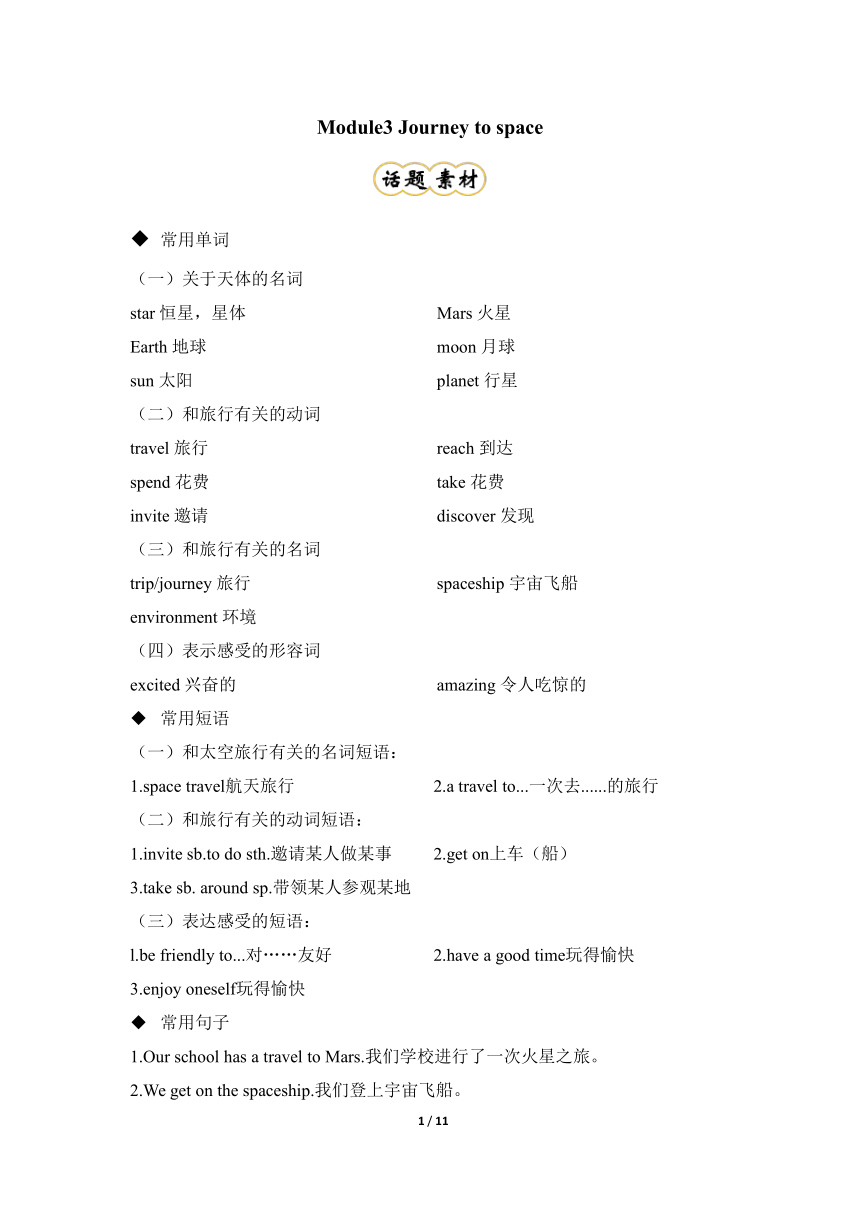
|
|
| 格式 | doc | ||
| 文件大小 | 116.0KB | ||
| 资源类型 | 教案 | ||
| 版本资源 | 外研版 | ||
| 科目 | 英语 | ||
| 更新时间 | 2022-06-13 20:06:00 | ||
图片预览

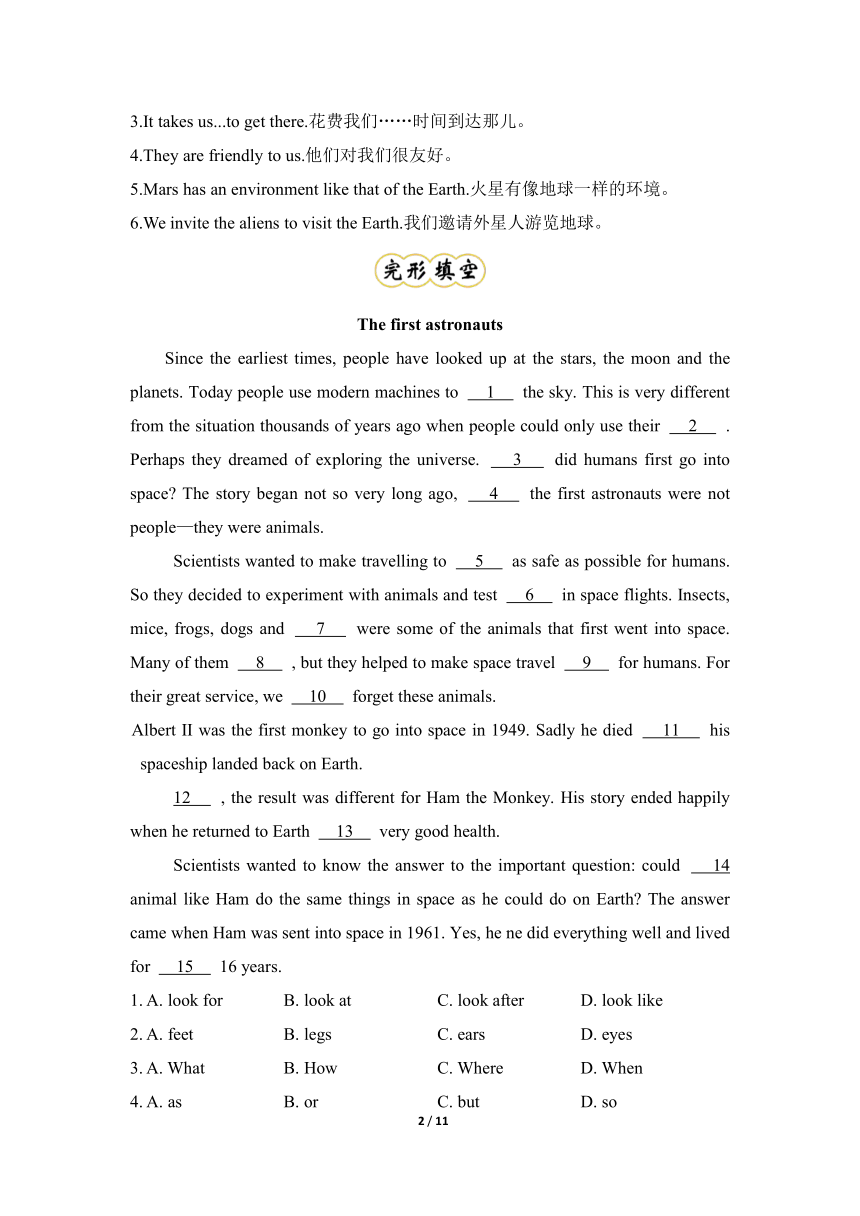
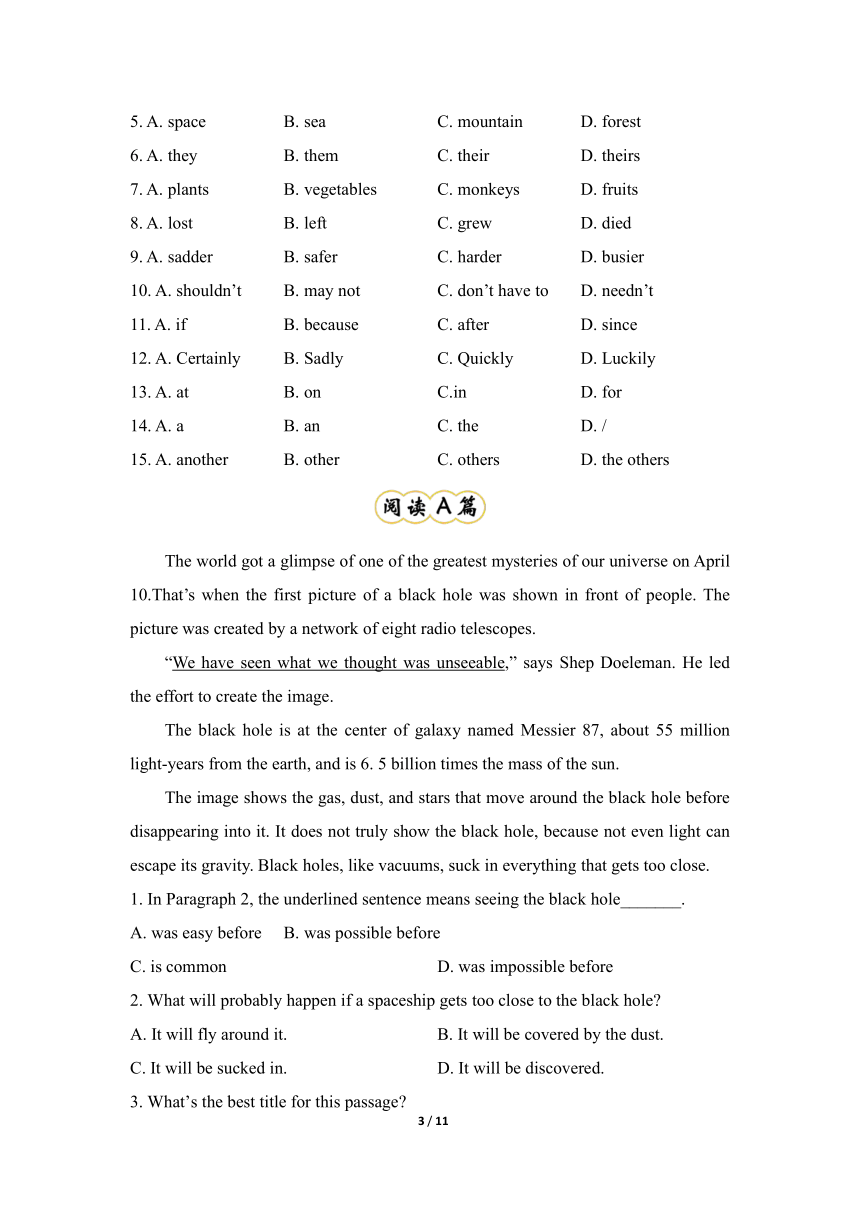
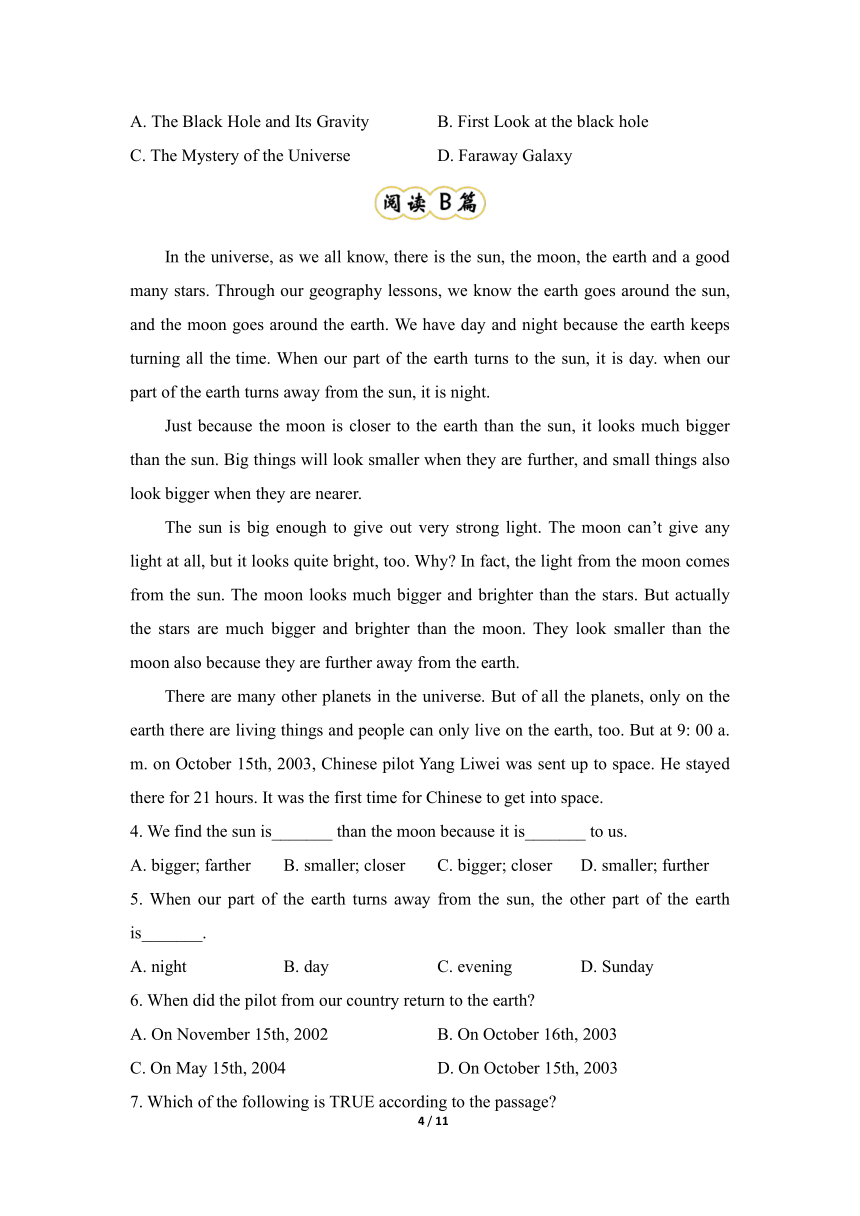
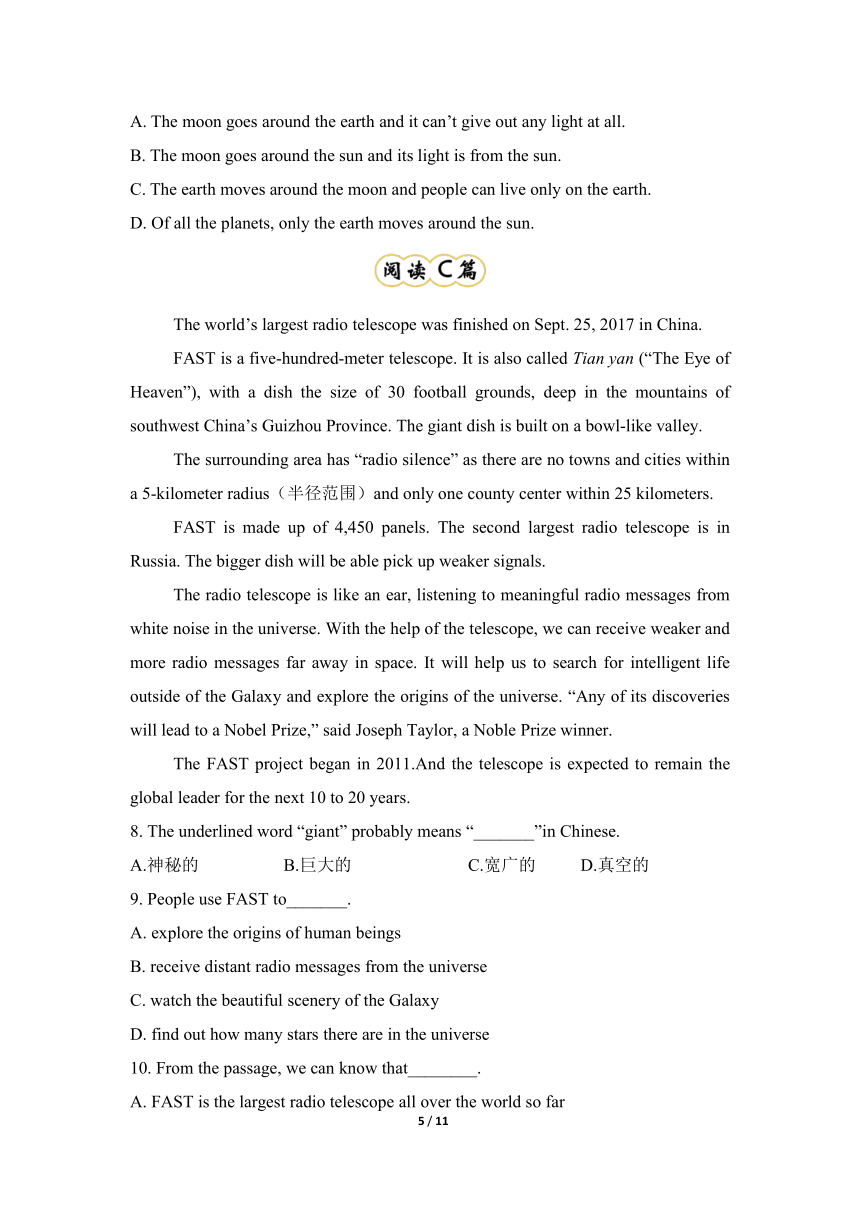
文档简介
Module3 Journey to space
常用单词
(一)关于天体的名词
star恒星,星体 Mars火星
Earth地球 moon月球
sun太阳 planet行星
(二)和旅行有关的动词
travel旅行 reach到达
spend花费 take花费
invite邀请 discover发现
(三)和旅行有关的名词
trip/journey旅行 spaceship宇宙飞船
environment环境
(四)表示感受的形容词
excited兴奋的 amazing令人吃惊的
常用短语
(一)和太空旅行有关的名词短语:
1.space travel航天旅行 2.a travel to...一次去......的旅行
(二)和旅行有关的动词短语:
1.invite sb.to do sth.邀请某人做某事 2.get on上车(船)
3.take sb. around sp.带领某人参观某地
(三)表达感受的短语:
l.be friendly to...对……友好 2.have a good time玩得愉快
3.enjoy oneself玩得愉快
常用句子
1.Our school has a travel to Mars.我们学校进行了一次火星之旅。
2.We get on the spaceship.我们登上宇宙飞船。
3.It takes us...to get there.花费我们……时间到达那儿。
4.They are friendly to us.他们对我们很友好。
5.Mars has an environment like that of the Earth.火星有像地球一样的环境。
6.We invite the aliens to visit the Earth.我们邀请外星人游览地球。
The first astronauts
Since the earliest times, people have looked up at the stars, the moon and the planets. Today people use modern machines to 1 the sky. This is very different from the situation thousands of years ago when people could only use their 2 . Perhaps they dreamed of exploring the universe. 3 did humans first go into space The story began not so very long ago, 4 the first astronauts were not people—they were animals.
Scientists wanted to make travelling to 5 as safe as possible for humans. So they decided to experiment with animals and test 6 in space flights. Insects, mice, frogs, dogs and 7 were some of the animals that first went into space. Many of them 8 , but they helped to make space travel 9 for humans. For their great service, we 10 forget these animals.
Albert II was the first monkey to go into space in 1949. Sadly he died 11 his spaceship landed back on Earth.
12 , the result was different for Ham the Monkey. His story ended happily when he returned to Earth 13 very good health.
Scientists wanted to know the answer to the important question: could 14 animal like Ham do the same things in space as he could do on Earth The answer came when Ham was sent into space in 1961. Yes, he ne did everything well and lived for 15 16 years.
1. A. look for B. look at C. look after D. look like
2. A. feet B. legs C. ears D. eyes
3. A. What B. How C. Where D. When
4. A. as B. or C. but D. so
5. A. space B. sea C. mountain D. forest
6. A. they B. them C. their D. theirs
7. A. plants B. vegetables C. monkeys D. fruits
8. A. lost B. left C. grew D. died
9. A. sadder B. safer C. harder D. busier
10. A. shouldn’t B. may not C. don’t have to D. needn’t
11. A. if B. because C. after D. since
12. A. Certainly B. Sadly C. Quickly D. Luckily
13. A. at B. on C.in D. for
14. A. a B. an C. the D. /
15. A. another B. other C. others D. the others
The world got a glimpse of one of the greatest mysteries of our universe on April 10.That’s when the first picture of a black hole was shown in front of people. The picture was created by a network of eight radio telescopes.
“We have seen what we thought was unseeable,” says Shep Doeleman. He led the effort to create the image.
The black hole is at the center of galaxy named Messier 87, about 55 million light-years from the earth, and is 6. 5 billion times the mass of the sun.
The image shows the gas, dust, and stars that move around the black hole before disappearing into it. It does not truly show the black hole, because not even light can escape its gravity. Black holes, like vacuums, suck in everything that gets too close.
1. In Paragraph 2, the underlined sentence means seeing the black hole_______.
A. was easy before B. was possible before
C. is common D. was impossible before
2. What will probably happen if a spaceship gets too close to the black hole
A. It will fly around it. B. It will be covered by the dust.
C. It will be sucked in. D. It will be discovered.
3. What’s the best title for this passage
A. The Black Hole and Its Gravity B. First Look at the black hole
C. The Mystery of the Universe D. Faraway Galaxy
In the universe, as we all know, there is the sun, the moon, the earth and a good many stars. Through our geography lessons, we know the earth goes around the sun, and the moon goes around the earth. We have day and night because the earth keeps turning all the time. When our part of the earth turns to the sun, it is day. when our part of the earth turns away from the sun, it is night.
Just because the moon is closer to the earth than the sun, it looks much bigger than the sun. Big things will look smaller when they are further, and small things also look bigger when they are nearer.
The sun is big enough to give out very strong light. The moon can’t give any light at all, but it looks quite bright, too. Why In fact, the light from the moon comes from the sun. The moon looks much bigger and brighter than the stars. But actually the stars are much bigger and brighter than the moon. They look smaller than the moon also because they are further away from the earth.
There are many other planets in the universe. But of all the planets, only on the earth there are living things and people can only live on the earth, too. But at 9: 00 a. m. on October 15th, 2003, Chinese pilot Yang Liwei was sent up to space. He stayed there for 21 hours. It was the first time for Chinese to get into space.
4. We find the sun is_______ than the moon because it is_______ to us.
A. bigger; farther B. smaller; closer C. bigger; closer D. smaller; further
5. When our part of the earth turns away from the sun, the other part of the earth is_______.
A. night B. day C. evening D. Sunday
6. When did the pilot from our country return to the earth
A. On November 15th, 2002 B. On October 16th, 2003
C. On May 15th, 2004 D. On October 15th, 2003
7. Which of the following is TRUE according to the passage
A. The moon goes around the earth and it can’t give out any light at all.
B. The moon goes around the sun and its light is from the sun.
C. The earth moves around the moon and people can live only on the earth.
D. Of all the planets, only the earth moves around the sun.
The world’s largest radio telescope was finished on Sept. 25, 2017 in China.
FAST is a five-hundred-meter telescope. It is also called Tian yan (“The Eye of Heaven”), with a dish the size of 30 football grounds, deep in the mountains of southwest China’s Guizhou Province. The giant dish is built on a bowl-like valley.
The surrounding area has “radio silence” as there are no towns and cities within a 5-kilometer radius(半径范围)and only one county center within 25 kilometers.
FAST is made up of 4,450 panels. The second largest radio telescope is in Russia. The bigger dish will be able pick up weaker signals.
The radio telescope is like an ear, listening to meaningful radio messages from white noise in the universe. With the help of the telescope, we can receive weaker and more radio messages far away in space. It will help us to search for intelligent life outside of the Galaxy and explore the origins of the universe. “Any of its discoveries will lead to a Nobel Prize,” said Joseph Taylor, a Noble Prize winner.
The FAST project began in 2011.And the telescope is expected to remain the global leader for the next 10 to 20 years.
8. The underlined word “giant” probably means “_______”in Chinese.
A.神秘的 B.巨大的 C.宽广的 D.真空的
9. People use FAST to_______.
A. explore the origins of human beings
B. receive distant radio messages from the universe
C. watch the beautiful scenery of the Galaxy
D. find out how many stars there are in the universe
10. From the passage, we can know that________.
A. FAST is the largest radio telescope all over the world so far
B. noisy towns are around the telescope within a 5-kilometer radius
C. the second largest radio telescope is made up of 4,450 panels
D. only China can build radio telescopes in the world
11. How long did it take to finish the FAST project
A. About twenty years. B. About ten years.
C. About six years. D. About three years.
For thousands of years, humans have explored the Earth. Nowadays, we are exploring space. Astronomers are the modern-day explorers. Now, many astronomers are looking for new planets and new places for humans to live in the future. But where do astronomers start looking
First of all, astronomers look for a star. That’s because our own Earth moves around a star (the Sun). More importantly, it is the correct distance from the Sun for heat and light. So when astronomers have found the star, they look at the planets around it. In recent years, astronomers have found nearly 400 new planets with stars. However, many of these planets are either too near to the star or too far away.
However, if the planet is in a good position, astronomers look for three key things: water, air and rock. Water is important because all life needs water. Humans can drink it and also grow plants with water And plants produce air for humans to breathe and food to eat. Rock on a planet is also important. That’s because there is often water under e rock.
After many years of scrutinizing, astronomers have found a planet that is similar to the Earth. It’s Gliese 581gand it’s near a star. The astronomers think it has water and rock and the average temperature is between -31°C and -12°C. That’s cold, but not colder than Antarctica or the Arctic Circle. Gliese 581g is bigger than the Earth. A year on Gliese 581g is only 37 Earth days instead of 365. But astronomers do not think these are big differences and some of them think Gliese 581g will be a new Earth. However, Gliese 581g is twenty light years from the Earth.
12. What do astronomers have to find first before starting to look for a new place for humans to live
A. A new star B. A new planet C. Some heat D. Some light.
13. What does the rock on a planet tell us
A. The star is in a right position.
B. We may discover water under it.
C. The planet is too near to the Sun.
D. There can be air around the rock.
14. What does the underlined word “scrutinizing” mean in the last paragraph
A. talking about B. waiting for C. looking for D. counting down
15. What’s Gliese 581g Please introduce it with about fifty words.
_____________________________________________________________________
参考答案:
完形填空
【主旨大意】本文是一篇说明文。文中主要讲述了第一批进入太空的宇航员不是人类,而是动物。科学家们发现动物Ham在太空中能像在地球上一样做同样的事情,离开太空后,它又存活了16年。
1.B 考査动词短语辨析。句意:现在人们使用现代的机器来观测太空。根据上文“Since the earliest times,people have looked up at the stars...”可知为“观测太空”。
2.D 考査名词辨析。根据上文“用现代机器观测太空”可知“几千年前人们用眼睛观测太空”。
3.D 考查疑问词辨析。根据下文“not so very long ago”可知上句询问“人类何时首次进入太空?”。
4.C 考查连词辨析。as“因为”;or“否则”;but“但是”;so“所以”。前半句“(人类第一次进入太空)这个故事发生在不久之前”和后半句“第一批宇航员不是人类—它们是动物”语意上为转折关系,but符合语境。
5.A 考查名词辨析。根据上下文可知为“科学家想让人类的太空之旅尽可能安全”。
6.B 考查代词辨析。they“他们”,主格形式;them“他们”,宾格形式;their“他们的”,形容词性物主代词;theirs“他们的”,名词性物主代词。分析句子结构可知,此处作动词test的宾语,指代前面的 animals,要用代词的宾格形式,故选B。
7.C 考查名词辨析。根据上下文叙述“第一批进入太空的是动物”,故此处选 monkeys。
8.D 考查动词辨析。根据下文叙述可知“许多第一批进入太空的动物死掉了”。
9.B 考查形容词辨析。句意:它们中的许多死了,但是它们帮助人们使太空旅行变得更安全。根据上文中的“as safe as possible for humans”可知“用动物做试验的目的是让人类的太空之旅更安全”。
10.A 考查情态动词辨析。根据前半句“因为它们的巨大贡献”可知此处表示“我们不应该忘记这些动物”。
11.C 考查连词辨析。句意:令人伤心的是它在太空飞船降落到地球之后死了。
12.D 考查副词辨析。句意:幸运的是,对于猴子Ham来说结果是不同的。根据上文“第一只进入太空的猴子在太空飞船降落到地球之后死了”和下文“Ham返回地球后健康状况很好”可知此处应为“幸运的是”。
13.C 考查固定用法,in good health意为“身体好”,是固定短语。
14.B 考查冠词辨析。animal是以元音音素开头的可数名词,且此处表泛指,应用不定冠词an。
15.A 考查限定词辨析,another“又一”;other“其他的”;others“(没有范围的)其他人或物”;the others“(某一范围内的)其他全部”。分析句子结构可知,此处修饰名词短语16years,故排除C、D两项。根据前半句“它所有事情都做得很好”可知,此处表示“它又活了16年”。
阅读A篇
【主旨大意】本文是一篇说明文,介绍了由射电望远镜拍摄的第一张黑洞照片公布于众的事件,及由这张照片得到的一些重要信息。
1.D 推理判断题。根据上文可知,这是第一张黑洞照片,故可推知“看见黑洞在以前是不可能的”。
2.C 推理判断题。根据最后一段中的“Black holes,like vacuums,suck in everything that gets too close.”可推知“如果一艘宇宙飞船靠黑洞太近,它就会被吸进黑洞”。
3.B 标题归纳题。通读全文可知,文章主要介绍了有关第一张黑洞照片的信息。
阅读B篇
【主旨大意】本文介绍了太阳、地球和月球三者在宇宙中的关系。
4.D 细节理解题。根据第二段中的“Just because the moon is closer to the earth than the sun,it looks much bigger than the sun.”可知,“月球看上去比太阳大是因为与月球相比太阳距离我们更远”。
5.B 细节理解题。根据第一段中的“When our part of the earth turns to the sun,it is day. When our part of the earth turns away from the sun,it is night.”可知,“当地球上我们的地方背向太阳时,我们这一面是晚上,则另一面是白天”。
6.B 数字计算题。根据最后一段中的 “But at 9:00 a. m. on October 15th, 2003, Chinese pilot Yang Liwei was sent up to space. He stayed there for 21 hours.”可知“杨利伟应该是在10月16日回到地球的”。
7.A 细节理解题。根据第一段中的“Through our geography lessons,we know the earth goes around the sun.,”和第三段中的“The moon can’t give any light at all,but it looks quite bright,too.”可知A项正确。
阅读C篇
【主旨大意】世界上最大的射电望远镜于2017年9月25日在中国完工。FAST是一个500米口径的望远镜,也被称为“天眼”,有30个足球场那么大,位于中国西南部贵州省的深山之中。
8.B 词义猜测题。由句子“...with a dish the size of 30 football grounds...”可知“FAST有30个足球场那么大”。由此可知FAST是“巨大的”。
9.B 细节理解题。由倒数第二段中的“With the help of the telescope,we can receive weaker and more radio messages far away in space.”可知“FAST是用来从遥远的宇宙中收集远程无线电信息的”。
10.A 细节理解题。由第一段“The world’s largest radio telescope was finished on Sept.25,2017 in China.”可知“FAST是目前世界上最大的射电望远镜”。
11.C 推理判断题。由第一段“The world’s largest radio elescope was finished on Sept.25,2017 in China.”可知,“2017年FAST建成”;最后一段中的“The FAST project began in2011.”说明“人们于2011年开始建造FAST”。由此可推断FAST工程共计花费了大约6年的时间。
阅读D篇
【主旨大意】数千年来,人类一直在探索宇宙,现在天文学家正在寻找适合人类未来生活的新行星和新地方,他们已经发现了一颗与地球相似的行星—Gliese581g。
12.A 细节理解题。根据第二段第一句“First of all,astronomers look for a star.”可知“宇航员首先要找一颗新恒星”。
13.B 细节理解题。根据第三段最后两句“Rock on a planet is also important. That’s because there is often water under the rock.”可知“岩石下面经常有水”。
14.C 词义猜测题。前面几段介绍了天文学家一直在寻找适合人类生存的星球,此处句意为“经过这么多年的,天文学家发现了一个与地球相似的星球。该词应是“寻找,探索”的意思,即 look for。
15. Gliese 581g is a planet that is similar to the Earth. It has water and rock and the average temperature is between31 C and-12 C. Gliese 581g is bigger than the Earth. A year on Gliese 581g is only 37 Earth days. Maybe people will live on it in the future.(考查要点:介绍其身份及有关数据信息即可)
2 / 11
常用单词
(一)关于天体的名词
star恒星,星体 Mars火星
Earth地球 moon月球
sun太阳 planet行星
(二)和旅行有关的动词
travel旅行 reach到达
spend花费 take花费
invite邀请 discover发现
(三)和旅行有关的名词
trip/journey旅行 spaceship宇宙飞船
environment环境
(四)表示感受的形容词
excited兴奋的 amazing令人吃惊的
常用短语
(一)和太空旅行有关的名词短语:
1.space travel航天旅行 2.a travel to...一次去......的旅行
(二)和旅行有关的动词短语:
1.invite sb.to do sth.邀请某人做某事 2.get on上车(船)
3.take sb. around sp.带领某人参观某地
(三)表达感受的短语:
l.be friendly to...对……友好 2.have a good time玩得愉快
3.enjoy oneself玩得愉快
常用句子
1.Our school has a travel to Mars.我们学校进行了一次火星之旅。
2.We get on the spaceship.我们登上宇宙飞船。
3.It takes us...to get there.花费我们……时间到达那儿。
4.They are friendly to us.他们对我们很友好。
5.Mars has an environment like that of the Earth.火星有像地球一样的环境。
6.We invite the aliens to visit the Earth.我们邀请外星人游览地球。
The first astronauts
Since the earliest times, people have looked up at the stars, the moon and the planets. Today people use modern machines to 1 the sky. This is very different from the situation thousands of years ago when people could only use their 2 . Perhaps they dreamed of exploring the universe. 3 did humans first go into space The story began not so very long ago, 4 the first astronauts were not people—they were animals.
Scientists wanted to make travelling to 5 as safe as possible for humans. So they decided to experiment with animals and test 6 in space flights. Insects, mice, frogs, dogs and 7 were some of the animals that first went into space. Many of them 8 , but they helped to make space travel 9 for humans. For their great service, we 10 forget these animals.
Albert II was the first monkey to go into space in 1949. Sadly he died 11 his spaceship landed back on Earth.
12 , the result was different for Ham the Monkey. His story ended happily when he returned to Earth 13 very good health.
Scientists wanted to know the answer to the important question: could 14 animal like Ham do the same things in space as he could do on Earth The answer came when Ham was sent into space in 1961. Yes, he ne did everything well and lived for 15 16 years.
1. A. look for B. look at C. look after D. look like
2. A. feet B. legs C. ears D. eyes
3. A. What B. How C. Where D. When
4. A. as B. or C. but D. so
5. A. space B. sea C. mountain D. forest
6. A. they B. them C. their D. theirs
7. A. plants B. vegetables C. monkeys D. fruits
8. A. lost B. left C. grew D. died
9. A. sadder B. safer C. harder D. busier
10. A. shouldn’t B. may not C. don’t have to D. needn’t
11. A. if B. because C. after D. since
12. A. Certainly B. Sadly C. Quickly D. Luckily
13. A. at B. on C.in D. for
14. A. a B. an C. the D. /
15. A. another B. other C. others D. the others
The world got a glimpse of one of the greatest mysteries of our universe on April 10.That’s when the first picture of a black hole was shown in front of people. The picture was created by a network of eight radio telescopes.
“We have seen what we thought was unseeable,” says Shep Doeleman. He led the effort to create the image.
The black hole is at the center of galaxy named Messier 87, about 55 million light-years from the earth, and is 6. 5 billion times the mass of the sun.
The image shows the gas, dust, and stars that move around the black hole before disappearing into it. It does not truly show the black hole, because not even light can escape its gravity. Black holes, like vacuums, suck in everything that gets too close.
1. In Paragraph 2, the underlined sentence means seeing the black hole_______.
A. was easy before B. was possible before
C. is common D. was impossible before
2. What will probably happen if a spaceship gets too close to the black hole
A. It will fly around it. B. It will be covered by the dust.
C. It will be sucked in. D. It will be discovered.
3. What’s the best title for this passage
A. The Black Hole and Its Gravity B. First Look at the black hole
C. The Mystery of the Universe D. Faraway Galaxy
In the universe, as we all know, there is the sun, the moon, the earth and a good many stars. Through our geography lessons, we know the earth goes around the sun, and the moon goes around the earth. We have day and night because the earth keeps turning all the time. When our part of the earth turns to the sun, it is day. when our part of the earth turns away from the sun, it is night.
Just because the moon is closer to the earth than the sun, it looks much bigger than the sun. Big things will look smaller when they are further, and small things also look bigger when they are nearer.
The sun is big enough to give out very strong light. The moon can’t give any light at all, but it looks quite bright, too. Why In fact, the light from the moon comes from the sun. The moon looks much bigger and brighter than the stars. But actually the stars are much bigger and brighter than the moon. They look smaller than the moon also because they are further away from the earth.
There are many other planets in the universe. But of all the planets, only on the earth there are living things and people can only live on the earth, too. But at 9: 00 a. m. on October 15th, 2003, Chinese pilot Yang Liwei was sent up to space. He stayed there for 21 hours. It was the first time for Chinese to get into space.
4. We find the sun is_______ than the moon because it is_______ to us.
A. bigger; farther B. smaller; closer C. bigger; closer D. smaller; further
5. When our part of the earth turns away from the sun, the other part of the earth is_______.
A. night B. day C. evening D. Sunday
6. When did the pilot from our country return to the earth
A. On November 15th, 2002 B. On October 16th, 2003
C. On May 15th, 2004 D. On October 15th, 2003
7. Which of the following is TRUE according to the passage
A. The moon goes around the earth and it can’t give out any light at all.
B. The moon goes around the sun and its light is from the sun.
C. The earth moves around the moon and people can live only on the earth.
D. Of all the planets, only the earth moves around the sun.
The world’s largest radio telescope was finished on Sept. 25, 2017 in China.
FAST is a five-hundred-meter telescope. It is also called Tian yan (“The Eye of Heaven”), with a dish the size of 30 football grounds, deep in the mountains of southwest China’s Guizhou Province. The giant dish is built on a bowl-like valley.
The surrounding area has “radio silence” as there are no towns and cities within a 5-kilometer radius(半径范围)and only one county center within 25 kilometers.
FAST is made up of 4,450 panels. The second largest radio telescope is in Russia. The bigger dish will be able pick up weaker signals.
The radio telescope is like an ear, listening to meaningful radio messages from white noise in the universe. With the help of the telescope, we can receive weaker and more radio messages far away in space. It will help us to search for intelligent life outside of the Galaxy and explore the origins of the universe. “Any of its discoveries will lead to a Nobel Prize,” said Joseph Taylor, a Noble Prize winner.
The FAST project began in 2011.And the telescope is expected to remain the global leader for the next 10 to 20 years.
8. The underlined word “giant” probably means “_______”in Chinese.
A.神秘的 B.巨大的 C.宽广的 D.真空的
9. People use FAST to_______.
A. explore the origins of human beings
B. receive distant radio messages from the universe
C. watch the beautiful scenery of the Galaxy
D. find out how many stars there are in the universe
10. From the passage, we can know that________.
A. FAST is the largest radio telescope all over the world so far
B. noisy towns are around the telescope within a 5-kilometer radius
C. the second largest radio telescope is made up of 4,450 panels
D. only China can build radio telescopes in the world
11. How long did it take to finish the FAST project
A. About twenty years. B. About ten years.
C. About six years. D. About three years.
For thousands of years, humans have explored the Earth. Nowadays, we are exploring space. Astronomers are the modern-day explorers. Now, many astronomers are looking for new planets and new places for humans to live in the future. But where do astronomers start looking
First of all, astronomers look for a star. That’s because our own Earth moves around a star (the Sun). More importantly, it is the correct distance from the Sun for heat and light. So when astronomers have found the star, they look at the planets around it. In recent years, astronomers have found nearly 400 new planets with stars. However, many of these planets are either too near to the star or too far away.
However, if the planet is in a good position, astronomers look for three key things: water, air and rock. Water is important because all life needs water. Humans can drink it and also grow plants with water And plants produce air for humans to breathe and food to eat. Rock on a planet is also important. That’s because there is often water under e rock.
After many years of scrutinizing, astronomers have found a planet that is similar to the Earth. It’s Gliese 581gand it’s near a star. The astronomers think it has water and rock and the average temperature is between -31°C and -12°C. That’s cold, but not colder than Antarctica or the Arctic Circle. Gliese 581g is bigger than the Earth. A year on Gliese 581g is only 37 Earth days instead of 365. But astronomers do not think these are big differences and some of them think Gliese 581g will be a new Earth. However, Gliese 581g is twenty light years from the Earth.
12. What do astronomers have to find first before starting to look for a new place for humans to live
A. A new star B. A new planet C. Some heat D. Some light.
13. What does the rock on a planet tell us
A. The star is in a right position.
B. We may discover water under it.
C. The planet is too near to the Sun.
D. There can be air around the rock.
14. What does the underlined word “scrutinizing” mean in the last paragraph
A. talking about B. waiting for C. looking for D. counting down
15. What’s Gliese 581g Please introduce it with about fifty words.
_____________________________________________________________________
参考答案:
完形填空
【主旨大意】本文是一篇说明文。文中主要讲述了第一批进入太空的宇航员不是人类,而是动物。科学家们发现动物Ham在太空中能像在地球上一样做同样的事情,离开太空后,它又存活了16年。
1.B 考査动词短语辨析。句意:现在人们使用现代的机器来观测太空。根据上文“Since the earliest times,people have looked up at the stars...”可知为“观测太空”。
2.D 考査名词辨析。根据上文“用现代机器观测太空”可知“几千年前人们用眼睛观测太空”。
3.D 考查疑问词辨析。根据下文“not so very long ago”可知上句询问“人类何时首次进入太空?”。
4.C 考查连词辨析。as“因为”;or“否则”;but“但是”;so“所以”。前半句“(人类第一次进入太空)这个故事发生在不久之前”和后半句“第一批宇航员不是人类—它们是动物”语意上为转折关系,but符合语境。
5.A 考查名词辨析。根据上下文可知为“科学家想让人类的太空之旅尽可能安全”。
6.B 考查代词辨析。they“他们”,主格形式;them“他们”,宾格形式;their“他们的”,形容词性物主代词;theirs“他们的”,名词性物主代词。分析句子结构可知,此处作动词test的宾语,指代前面的 animals,要用代词的宾格形式,故选B。
7.C 考查名词辨析。根据上下文叙述“第一批进入太空的是动物”,故此处选 monkeys。
8.D 考查动词辨析。根据下文叙述可知“许多第一批进入太空的动物死掉了”。
9.B 考查形容词辨析。句意:它们中的许多死了,但是它们帮助人们使太空旅行变得更安全。根据上文中的“as safe as possible for humans”可知“用动物做试验的目的是让人类的太空之旅更安全”。
10.A 考查情态动词辨析。根据前半句“因为它们的巨大贡献”可知此处表示“我们不应该忘记这些动物”。
11.C 考查连词辨析。句意:令人伤心的是它在太空飞船降落到地球之后死了。
12.D 考查副词辨析。句意:幸运的是,对于猴子Ham来说结果是不同的。根据上文“第一只进入太空的猴子在太空飞船降落到地球之后死了”和下文“Ham返回地球后健康状况很好”可知此处应为“幸运的是”。
13.C 考查固定用法,in good health意为“身体好”,是固定短语。
14.B 考查冠词辨析。animal是以元音音素开头的可数名词,且此处表泛指,应用不定冠词an。
15.A 考查限定词辨析,another“又一”;other“其他的”;others“(没有范围的)其他人或物”;the others“(某一范围内的)其他全部”。分析句子结构可知,此处修饰名词短语16years,故排除C、D两项。根据前半句“它所有事情都做得很好”可知,此处表示“它又活了16年”。
阅读A篇
【主旨大意】本文是一篇说明文,介绍了由射电望远镜拍摄的第一张黑洞照片公布于众的事件,及由这张照片得到的一些重要信息。
1.D 推理判断题。根据上文可知,这是第一张黑洞照片,故可推知“看见黑洞在以前是不可能的”。
2.C 推理判断题。根据最后一段中的“Black holes,like vacuums,suck in everything that gets too close.”可推知“如果一艘宇宙飞船靠黑洞太近,它就会被吸进黑洞”。
3.B 标题归纳题。通读全文可知,文章主要介绍了有关第一张黑洞照片的信息。
阅读B篇
【主旨大意】本文介绍了太阳、地球和月球三者在宇宙中的关系。
4.D 细节理解题。根据第二段中的“Just because the moon is closer to the earth than the sun,it looks much bigger than the sun.”可知,“月球看上去比太阳大是因为与月球相比太阳距离我们更远”。
5.B 细节理解题。根据第一段中的“When our part of the earth turns to the sun,it is day. When our part of the earth turns away from the sun,it is night.”可知,“当地球上我们的地方背向太阳时,我们这一面是晚上,则另一面是白天”。
6.B 数字计算题。根据最后一段中的 “But at 9:00 a. m. on October 15th, 2003, Chinese pilot Yang Liwei was sent up to space. He stayed there for 21 hours.”可知“杨利伟应该是在10月16日回到地球的”。
7.A 细节理解题。根据第一段中的“Through our geography lessons,we know the earth goes around the sun.,”和第三段中的“The moon can’t give any light at all,but it looks quite bright,too.”可知A项正确。
阅读C篇
【主旨大意】世界上最大的射电望远镜于2017年9月25日在中国完工。FAST是一个500米口径的望远镜,也被称为“天眼”,有30个足球场那么大,位于中国西南部贵州省的深山之中。
8.B 词义猜测题。由句子“...with a dish the size of 30 football grounds...”可知“FAST有30个足球场那么大”。由此可知FAST是“巨大的”。
9.B 细节理解题。由倒数第二段中的“With the help of the telescope,we can receive weaker and more radio messages far away in space.”可知“FAST是用来从遥远的宇宙中收集远程无线电信息的”。
10.A 细节理解题。由第一段“The world’s largest radio telescope was finished on Sept.25,2017 in China.”可知“FAST是目前世界上最大的射电望远镜”。
11.C 推理判断题。由第一段“The world’s largest radio elescope was finished on Sept.25,2017 in China.”可知,“2017年FAST建成”;最后一段中的“The FAST project began in2011.”说明“人们于2011年开始建造FAST”。由此可推断FAST工程共计花费了大约6年的时间。
阅读D篇
【主旨大意】数千年来,人类一直在探索宇宙,现在天文学家正在寻找适合人类未来生活的新行星和新地方,他们已经发现了一颗与地球相似的行星—Gliese581g。
12.A 细节理解题。根据第二段第一句“First of all,astronomers look for a star.”可知“宇航员首先要找一颗新恒星”。
13.B 细节理解题。根据第三段最后两句“Rock on a planet is also important. That’s because there is often water under the rock.”可知“岩石下面经常有水”。
14.C 词义猜测题。前面几段介绍了天文学家一直在寻找适合人类生存的星球,此处句意为“经过这么多年的,天文学家发现了一个与地球相似的星球。该词应是“寻找,探索”的意思,即 look for。
15. Gliese 581g is a planet that is similar to the Earth. It has water and rock and the average temperature is between31 C and-12 C. Gliese 581g is bigger than the Earth. A year on Gliese 581g is only 37 Earth days. Maybe people will live on it in the future.(考查要点:介绍其身份及有关数据信息即可)
2 / 11
同课章节目录
- Module 1 Feelings and impressions
- Unit 1 It smells delicious.
- Unit 2 I feel nervous when I speak Chinese .
- Unit 3 Language in use
- Module 2 Experiences
- Unit 1 I've also entered lots of speaking competi
- Unit 2 They have seen the Pyramids.
- Unit 3 Language in use
- Module 3 Journey to space
- Unit 1 Has it arrived yet?
- Unit 2 We have not found life on any other planet
- Unit 3 Language in use
- Module 4 Seeing the docto
- Unit 1 I haven't done much exercise since I got m
- Unit 2 We have played football for a year now
- Unit 3 Language in use
- Module 5 Cartoons
- Unit 1 It's time to watch a cartoon.
- Unit 2 Tintin has been popular for over eighty yea
- Unit 3 Language in use
- Revision module A
- Module 6 Hobbies
- Unit 1 Do you collect anything ?
- Unit 2 Hobbies can make you grow as a person.
- Unit 3 Language in use
- Module 7 Summer in Los Angeles
- Unit 1 Please write to me and send me some photos
- Unit 2 Fill out a form and come to learn English
- Unit 3 Language in use
- Module 8 Time off
- Unit 1 I can hardly believe we are in the city ce
- Unit 2 We thought somebody was moving about
- Unit 3 Language in use
- Module 9 Friendship
- Unit 1 Could I ask if you've mentioned this to he
- Unit 2 I believe that the world is what you think
- Unit 3 Language in use
- Module 10 On the radio
- Unit 1 I hope that you can join us one day
- Unit 2 It seemed that they were speaking to me in
- Unit 3 Language in use
- Revision module B
